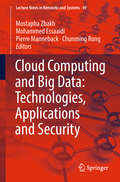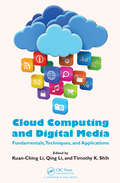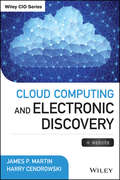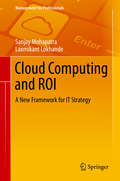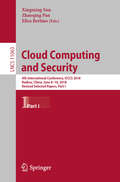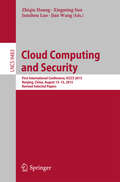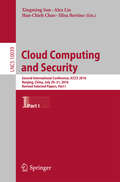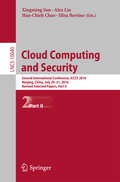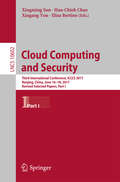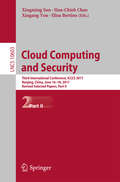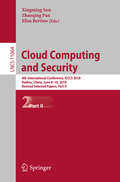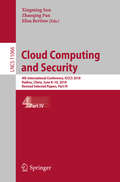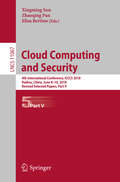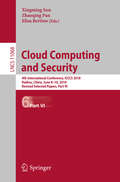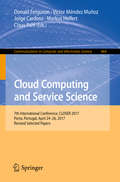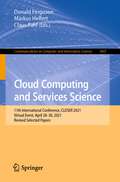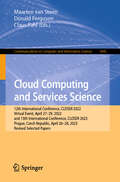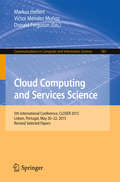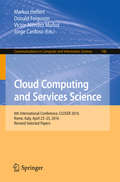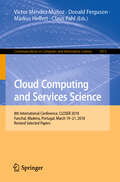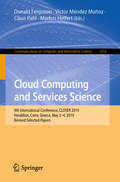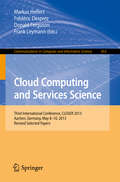- Table View
- List View
Cloud Computing and Big Data: Technologies, Applications and Security (Lecture Notes in Networks and Systems #49)
by Mostapha Zbakh Mohammed Essaaidi Pierre Manneback Chunming RongThis book addresses topics related to cloud and Big Data technologies, architecture and applications including distributed computing and data centers, cloud infrastructure and security, and end-user services. The majority of the book is devoted to the security aspects of cloud computing and Big Data. Cloud computing, which can be seen as any subscription-based or pay-per-use service that extends the Internet’s existing capabilities, has gained considerable attention from both academia and the IT industry as a new infrastructure requiring smaller investments in hardware platforms, staff training, or licensing software tools. It is a new paradigm that has ushered in a revolution in both data storage and computation. In parallel to this progress, Big Data technologies, which rely heavily on cloud computing platforms for both data storage and processing, have been developed and deployed at breathtaking speed. They are among the most frequently used technologies for developing applications and services in many fields, such as the web, health, and energy. Accordingly, cloud computing and Big Data technologies are two of the most central current and future research mainstreams. They involve and impact a host of fields, including business, scientific research, and public and private administration. Gathering extended versions of the best papers presented at the Third International Conference on Cloud Computing Technologies and Applications (CloudTech’17), this book offers a valuable resource for all Information System managers, researchers, students, developers, and policymakers involved in the technological and application aspects of cloud computing and Big Data.
Cloud Computing and Digital Media: Fundamentals, Techniques, and Applications
by Qing Li Timothy K. Shih Kuan-Ching LiCloud Computing and Digital Media: Fundamentals, Techniques, and Applications presents the fundamentals of cloud and media infrastructure, novel technologies that integrate digital media with cloud computing, and real-world applications that exemplify the potential of cloud computing for next-generation digital media. It brings together technologie
Cloud Computing and Electronic Discovery (Wiley CIO)
by Harry Cendrowski James P. MartinExplore the frontier of electronic discovery in the cloud Cloud Computing and Electronic Discovery comprehensively covers the quickly-evolving realm of eDiscovery in cloud computing environments, a computing and legal frontier in which the rules and legal precedents are being developed anew seemingly by the day. The book delves into this fascinating and rapidly-developing topic to prepare fraud investigators, legal professionals, forensic accountants, and executives understand the ramifications of storing data with third party providers and how such storage mechanisms relate to the limits of discovery practices. This up-to-date resource also includes a complete discussion of the few existing legal precedents and current cases that are shaping interpretation of discovery laws in the cloud space, a perfect overview for executives storing their companies' data in the cloud and the legal professionals tasked with understanding and interpreting the discovery rules surrounding that data. The book is comprehensive in scope and includes: An overview of current trends in cloud computing, including potential information that should be considered in an investigation that involves data held by a cloud service provider Updates on current and proposed laws governing discovery of information held by a third party cloud service provider Updates on legal cases that address the issues of the Electronic Communication Privacy Act, the Federal law prohibiting release of information by a third party provider Practical guidance on how to consider the availability of cloud data relevant to an investigation, and how to include this data in discovery plans For business, accounting, and legal professionals, Cloud Computing and Electronic Discovery is an invaluable resource for understanding the nuanced development of cloud eDiscovery policies, practices, and law as they continue to unfold and develop.
Cloud Computing and MicroServices
by Jinmin YangThis book explains cloud computing and microservices from the perspective of technological evolution, showing the ins and outs as well as the causes and consequences of cloud computing and microservices. The essence of cloud computing is to deepen resource sharing to improve cost-effectiveness by economies of scale and intensification. From a historical perspective, this book summarizes the 2 leaps of the computing paradigm: from stand-alone computing to cluster computing, and then from cluster computing to cloud computing. On the basis of cluster computing, cloud computing has to further solve two key problems : 1) application programs can run everywhere on the cloud; 2) application programs running on the same computer do not interfere with each other. Cloud computing has promoted informationization, bringing about new challenges to servers. Servers are facing the double pressure of increasing data volume and client requests, with the issue of service quality becoming increasingly critical. In this situation, the strategies and methods for servers to achieve efficiency, resilience, scalability, availability, security and consistency, as well as rapid development, rapid revision and upgrade, and fast startup are collectively known as microservice technologies.
Cloud Computing and ROI: A New Framework for IT Strategy (Management for Professionals)
by Sanjay Mohapatra Laxmikant LokhandeThis book develops an IT strategy for cloud computing that helps businesses evaluate their readiness for cloud services and calculate the ROI. The framework provided helps reduce risks involved in transitioning from traditional "on site" IT strategy to virtual "cloud computing. " Since the advent of cloud computing, many organizations have made substantial gains implementing this innovation. Cloud computing allows companies to focus more on their core competencies, as IT enablement is taken care of through cloud services. Cloud Computing and ROI includes case studies covering retail, automobile and food processing industries. Each of these case studies have successfully implemented the cloud computing framework and their strategies are explained. As cloud computing may not be ideal for all businesses, criteria are also offered to help determine if this strategy should be adopted.
Cloud Computing and Security: 4th International Conference, ICCCS 2018, Haikou, China, June 8-10, 2018, Revised Selected Papers, Part I (Lecture Notes in Computer Science #11063)
by Elisa Bertino Xingming Sun Zhaoqing PanThis six volume set LNCS 11063 – 11068 constitutes the thoroughly refereed conference proceedings of the 4th International Conference on Cloud Computing and Security, ICCCS 2018, held in Haikou, China, in June 2018. The 386 full papers of these six volumes were carefully reviewed and selected from 1743 submissions. The papers cover ideas and achievements in the theory and practice of all areas of inventive systems which includes control, artificial intelligence, automation systems, computing systems, electrical and informative systems. The six volumes are arranged according to the subject areas as follows: cloud computing, cloud security, encryption, information hiding, IoT security, multimedia forensics.
Cloud Computing and Security: First International Conference, ICCCS 2015, Nanjing, China, August 13-15, 2015. Revised Selected Papers (Lecture Notes in Computer Science #9483)
by Jian Wang Zhiqiu Huang Xingming Sun Junzhou LuoThis book constitutes the proceedings of the International Conference on Cloud Computing and Security (ICCCS 2015) will be held on August 13-15, 2015 in Nanjing, China. The objective of ICCCS 2015 is to provide a forum for researchers, academicians, engineers, industrial professionals, students and government officials involved in the general areas of information security and cloud computing.
Cloud Computing and Security: Second International Conference, ICCCS 2016, Nanjing, China, July 29-31, 2016, Revised Selected Papers, Part I (Lecture Notes in Computer Science #10039)
by Alex Liu Elisa Bertino Xingming Sun Han-Chieh ChaoThis two volume set LNCS 10039 and LNCS 10040 constitutes the thoroughly refereed post-conference proceedings of the Second International Conference on Cloud Computing and Security, ICCCS 2016, held in Nanjing, China, during July 29-31, 2016. The 97 papers of these volumes were carefully reviewed and selected from 272 submissions. The papers are organized in topical sections such as: Information Hiding, Cloud Computing, Cloud Security, IOT Applications, Multimedia Applications, Multimedia Security and Forensics.
Cloud Computing and Security: Second International Conference, ICCCS 2016, Nanjing, China, July 29-31, 2016, Revised Selected Papers, Part II (Lecture Notes in Computer Science #10040)
by Alex Liu Elisa Bertino Xingming Sun Han-Chieh ChaoThis two volume set LNCS 10039 and LNCS 10040 constitutes the thoroughly refereed post-conference proceedings of the Second International Conference on Cloud Computing and Security, ICCCS 2016, held in Nanjing, China, during July 29-31, 2016. The 97 papers of these volumes were carefully reviewed and selected from 272 submissions. The papers are organized in topical sections such as: Information Hiding, Cloud Computing, Cloud Security, IOT Applications, Multimedia Applications, Multimedia Security and Forensics.
Cloud Computing and Security: Third International Conference, ICCCS 2017, Nanjing, China, June 16-18, 2017, Revised Selected Papers, Part I (Lecture Notes in Computer Science #10602)
by Elisa Bertino Xingming Sun Han-Chieh Chao Xingang YouThis two volume set LNCS 10039 and LNCS 10040 constitutes the thoroughly refereed post-conference proceedings of the Second International Conference on Cloud Computing and Security, ICCCS 2016, held in Nanjing, China, during July 29-31, 2016. The 97 papers of these volumes were carefully reviewed and selected from 272 submissions. The papers are organized in topical sections such as: Information Hiding, Cloud Computing, Cloud Security, IOT Applications, Multimedia Applications, Multimedia Security and Forensics.
Cloud Computing and Security: Third International Conference, ICCCS 2017, Nanjing, China, June 16-18, 2017, Revised Selected Papers, Part II (Lecture Notes in Computer Science #10603)
by Elisa Bertino Xingming Sun Han-Chieh Chao Xingang YouThis two volume set LNCS 10039 and LNCS 10040 constitutes the thoroughly refereed post-conference proceedings of the Second International Conference on Cloud Computing and Security, ICCCS 2016, held in Nanjing, China, during July 29-31, 2016. The 97 papers of these volumes were carefully reviewed and selected from 272 submissions. The papers are organized in topical sections such as: Information Hiding, Cloud Computing, Cloud Security, IOT Applications, Multimedia Applications, Multimedia Security and Forensics.
Cloud Computing and Security: Third International Conference, Icccs 2017, Nanjing, China, June 16-18, 2017, Revised Selected Papers, Part Ii (Lecture Notes in Computer Science #10603)
by Elisa Bertino Xingming Sun Zhaoqing PanThis six volume set LNCS 11063 – 11068 constitutes the thoroughly refereed conference proceedings of the 4th International Conference on Cloud Computing and Security, ICCCS 2018, held in Haikou, China, in June 2018. The 386 full papers of these six volumes were carefully reviewed and selected from 1743 submissions. The papers cover ideas and achievements in the theory and practice of all areas of inventive systems which includes control, artificial intelligence, automation systems, computing systems, electrical and informative systems. The six volumes are arranged according to the subject areas as follows: cloud computing, cloud security, encryption, information hiding, IoT security, multimedia forensics.
Cloud Computing and Security: Third International Conference, Icccs 2017, Nanjing, China, June 16-18, 2017, Revised Selected Papers, Part Ii (Lecture Notes in Computer Science #10603)
by Elisa Bertino Xingming Sun Zhaoqing PanThis six volume set LNCS 11063 – 11068 constitutes the thoroughly refereed conference proceedings of the 4th International Conference on Cloud Computing and Security, ICCCS 2018, held in Haikou, China, in June 2018. The 386 full papers of these six volumes were carefully reviewed and selected from 1743 submissions. The papers cover ideas and achievements in the theory and practice of all areas of inventive systems which includes control, artificial intelligence, automation systems, computing systems, electrical and informative systems. The six volumes are arranged according to the subject areas as follows: cloud computing, cloud security, encryption, information hiding, IoT security, multimedia forensics.
Cloud Computing and Security: Third International Conference, Icccs 2017, Nanjing, China, June 16-18, 2017, Revised Selected Papers, Part Ii (Lecture Notes in Computer Science #10603)
by Elisa Bertino Xingming Sun Zhaoqing PanThis six volume set LNCS 11063 – 11068 constitutes the thoroughly refereed conference proceedings of the 4th International Conference on Cloud Computing and Security, ICCCS 2018, held in Haikou, China, in June 2018. The 386 full papers of these six volumes were carefully reviewed and selected from 1743 submissions. The papers cover ideas and achievements in the theory and practice of all areas of inventive systems which includes control, artificial intelligence, automation systems, computing systems, electrical and informative systems. The six volumes are arranged according to the subject areas as follows: cloud computing, cloud security, encryption, information hiding, IoT security, multimedia forensics
Cloud Computing and Security: Third International Conference, Icccs 2017, Nanjing, China, June 16-18, 2017, Revised Selected Papers, Part Ii (Lecture Notes in Computer Science #10603)
by Elisa Bertino Xingming Sun Zhaoqing PanThis six volume set LNCS 11063 – 11068 constitutes the thoroughly refereed conference proceedings of the 4th International Conference on Cloud Computing and Security, ICCCS 2018, held in Haikou, China, in June 2018. The 386 full papers of these six volumes were carefully reviewed and selected from 1743 submissions. The papers cover ideas and achievements in the theory and practice of all areas of inventive systems which includes control, artificial intelligence, automation systems, computing systems, electrical and informative systems. The six volumes are arranged according to the subject areas as follows: cloud computing, cloud security, encryption, information hiding, IoT security, multimedia forensics
Cloud Computing and Security: Third International Conference, Icccs 2017, Nanjing, China, June 16-18, 2017, Revised Selected Papers, Part Ii (Lecture Notes in Computer Science #10603)
by Elisa Bertino Xingming Sun Zhaoqing PanThis six volume set LNCS 11063 – 11068 constitutes the thoroughly refereed conference proceedings of the 4th International Conference on Cloud Computing and Security, ICCCS 2018, held in Haikou, China, in June 2018. The 386 full papers of these six volumes were carefully reviewed and selected from 1743 submissions. The papers cover ideas and achievements in the theory and practice of all areas of inventive systems which includes control, artificial intelligence, automation systems, computing systems, electrical and informative systems. The six volumes are arranged according to the subject areas as follows: cloud computing, cloud security, encryption, information hiding, IoT security, multimedia forensics
Cloud Computing and Service Science: 7th International Conference, CLOSER 2017, Porto, Portugal, April 24–26, 2017, Revised Selected Papers (Communications in Computer and Information Science #864)
by Markus Helfert Donald Ferguson Jorge Cardoso Víctor Méndez Muñoz Claus PahlThis book constitutes extended, revised and selected papers from the 7th Ith International Conference on Cloud Computing and Service Science, CLOSER 2017, held in Porto, Portugal, in April 2017. The 16 papers presented in this volume were carefully reviewed and selected from a total of 123 submissions. CLOSER 2017 focused on the emerging area of Cloud Computing, inspired by some latest advances that concern the infrastructure, operations and available services throughout the global network.
Cloud Computing and Services Science: 10th International Conference, CLOSER 2020, Prague, Czech Republic, May 7–9, 2020, Revised Selected Papers (Communications in Computer and Information Science #1399)
by Markus Helfert Donald Ferguson Claus PahlThis book constitutes extended, revised and selected papers from the 10th International Conference on Cloud Computing and Services Science, CLOSER 2020, held in Prague, Czech Republic, in May 2020. Due to the COVID-19 pandemic the conference was held in a virtual format.The 14 papers presented in this volume were carefully reviewed and selected from a total of 69 submissions. CLOSER 2020 focuses on the emerging area of cloud computing, inspired by some latest advances that concern the infrastructure, operations, and available servicesthrough the global network.
Cloud Computing and Services Science: 11th International Conference, CLOSER 2021, Virtual Event, April 28–30, 2021, Revised Selected Papers (Communications in Computer and Information Science #1607)
by Markus Helfert Donald Ferguson Claus PahlThis book constitutes the refereed proceedings of the 11th International Conference on Cloud Computing and Services Science, CLOSER 2021, Virtual Event, during April 28–30, 2021. The 5 full papers included in this book were carefully reviewed and selected from 51 submissions. The proceedings deal with the topics of data processing, cloud computing environments, and services science.
Cloud Computing and Services Science: 12th International Conference, CLOSER 2022, Virtual Event, April 27–29, 2022, and 13th International Conference, CLOSER 2023, Prague, Czech Republic, April 26–28, 2023, Revised Selected Papers (Communications in Computer and Information Science #1845)
by Donald Ferguson Maarten Van Steen Claus PahlThis book constitutes revised selected papers from the 12th and 13th International Conference on Cloud Computing and Services Science , CLOSER 2022 and CLOSER 2023, which took place as a virtual event in April 2022 and in Prague, Czech Republic, in April 2023. CLOSER 2022 received a total of 45 submissions out of which 3 papers are included in this book. From 46 submissions received for CLOSER 2023, 7 papers have been selected for inclusion in this book. They focus on latest advances and various aspects of cloud computing and the link to services science.
Cloud Computing and Services Science: 5th International Conference, CLOSER 2015, Lisbon, Portugal, May 20-22, 2015, Revised Selected Papers (Communications in Computer and Information Science #581)
by Markus Helfert Donald Ferguson Víctor Méndez MuñozThis book constitutes the thoroughly refereed proceedings of the 5th International Conference on Cloud Computing and Services Science, CLOSER 2015, held in Lisbon, Portugal, in May 2015. The 14 revised full papers presented together with one invited paper were selected from 146 paper submissions. The papers focus on the following topics: cloud computing fundamentals; services science foundations for cloud computing; cloud computing platforms and applications; cloud computing enabling technologies; and mobile cloud computing services.
Cloud Computing and Services Science: 6th International Conference, CLOSER 2016, Rome, Italy, April 23-25, 2016, Revised Selected Papers (Communications in Computer and Information Science #740)
by Markus Helfert Donald Ferguson Jorge Cardoso Victor Méndez MuñozNormal 0 false false false EN-US X-NONE X-NONE MicrosoftInternetExplorer4 This book constitutes the thoroughly refereed proceedings of the 4th International Conference on Cloud Computing and Services Science, CLOSER 2014, held in Barcelona, Spain, in April 2014. The 14 papers presented were selected from 127 paper submissions. The papers focus on the following topics: cloud computing fundamentals; services science foundations for cloud computing; cloud computing platforms and applications; cloud computing enabling technologies; and mobile cloud computing services. /* Style Definitions */ table. MsoNormalTable {{mso-style-name:"Table Normal"; mso-tstyle-rowband-size:0; mso-tstyle-colband-size:0; mso-style-noshow:yes; mso-style-priority:99; mso-style-qformat:yes; mso-style-parent:""; mso-padding-alt:0in 5. 4pt 0in 5. 4pt; mso-para-margin:0in; mso-para-margin-bottom:. 0001pt; mso-pagination:widow-orphan; font-size:11. 0pt; font-family:"Calibri","sans-serif"; mso-ascii-font-family:Calibri; mso-ascii-theme-font:minor-latin; mso-fareast-font-family:"Times New Roman"; mso-fareast-theme-font:minor-fareast; mso-hansi-font-family:Calibri; mso-hansi-theme-font:minor-latin; mso-bidi-font-family:"Times New Roman"; mso-bidi-theme-font:minor-bidi;}} ntStyles> e"/>
Cloud Computing and Services Science: 8th International Conference, CLOSER 2018, Funchal, Madeira, Portugal, March 19-21, 2018, Revised Selected Papers (Communications in Computer and Information Science #1073)
by Markus Helfert Donald Ferguson Víctor Méndez Muñoz Claus PahlThis book constitutes extended, revised and selected papers from the 8th International Conference on Cloud Computing and Services Science, CLOSER 2018, held in Funchal, Portugal in March 2018. The 11 papers presented in this volume were carefully reviewed and selected from a total of 94 submissions. CLOSER 2018 focused on the emerging area of Cloud Computing, inspired by some latest advances that concern the infrastructure, operations and available services throughout the global network.
Cloud Computing and Services Science: 9th International Conference, CLOSER 2019, Heraklion, Crete, Greece, May 2–4, 2019, Revised Selected Papers (Communications in Computer and Information Science #1218)
by Markus Helfert Donald Ferguson Víctor Méndez Muñoz Claus PahlThis book constitutes extended, revised and selected papers from the 9th International Conference on Cloud Computing and Services Science, CLOSER 2019, held in Heraklion, Greece, in May 2019.The 11 papers presented in this volume were carefully reviewed and selected from a total of 102 submissions. CLOSER 2019 focuses on the emerging area of Cloud Computing, inspired by some latest advances that concern the infrastructure, operations, and available servicesthrough the global network.
Cloud Computing and Services Science: Third International Conference, CLOSER 2013, Aachen, Germany, May 8-10, 2013, Revised Selected Papers (Communications in Computer and Information Science #453)
by Markus Helfert, Frédéric Desprez, Donald Ferguson and Frank LeymannThis book constitutes the thoroughly refereed proceedings of the Third International Conference on Cloud Computing and Services Science, CLOSER 2013, held in Aachen, Germany, in May 2013. The 8 papers presented were selected from 142 paper submissions. The papers cover the following topics: cloud computing fundamentals; services science foundations for cloud computing; cloud computing platforms and applications; and cloud computing enabling technologies.
